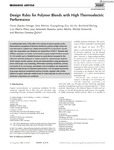Mostrar o rexistro simple do ítem
Design Rules for Polymer Blends with High Thermoelectric Performance
| dc.contributor.author | Zapata-Arteaga, Osnat | |
| dc.contributor.author | Marina, Sara | |
| dc.contributor.author | Zuo, Guangzheng | |
| dc.contributor.author | Xu, Kai | |
| dc.contributor.author | Dörling, Bernhard | |
| dc.contributor.author | Pérez, Luis Alberto | |
| dc.contributor.author | Reparaz, Juan Sebastian | |
| dc.contributor.author | Martín, Jaime | |
| dc.contributor.author | Kemerink, Martijn | |
| dc.contributor.author | Campoy-Quiles, Mariano | |
| dc.date.accessioned | 2022-07-01T11:31:03Z | |
| dc.date.available | 2022-07-01T11:31:03Z | |
| dc.date.issued | 2022-04-07 | |
| dc.identifier.citation | Zapata-Arteaga, O., Marina, S., Zuo, G., Xu, K., Dörling, B., Pérez, L. A., Reparaz, J. S., Martín, J., Kemerink, M., Campoy-Quiles, M., Design Rules for Polymer Blends with High Thermoelectric Performance. Adv. Energy Mater. 2022, 12, 2104076. https://doi.org/10.1002/aenm.202104076 | es_ES |
| dc.identifier.issn | 1614-6840 | |
| dc.identifier.uri | http://hdl.handle.net/2183/31051 | |
| dc.description.abstract | [Abstract] A combinatorial study of the effect of in-mixing of various guests on the thermoelectric properties of the host workhorse polymer poly[2,5-bis(3-tetradecylthiophen- 2-yl)thieno[3,2-b]thiophene] (PBTTT) is presented. Specifically, the composition and thickness for doped films of PBTTT blended with different polymers are varied. Some blends at guest weight fractions around 10–15% exhibit up to a fivefold increase in power factor compared to the reference material, leading to zT values around 0.1. Spectroscopic analysis of the charge-transfer species, structural characterization using grazing-incidence wide-angle X-ray scattering, differential scanning calorimetry, Raman, and atomic force microscopy, and Monte Carlo simulations are employed to determine that the key to improved performance is for the guest to promote long-range electrical connectivity and low disorder, together with similar highest occupied molecular orbital levels for both materials in order to ensure electronic connectivity are combined. | es_ES |
| dc.description.sponsorship | The authors acknowledge financial support from the Spanish Ministry of Science and Innovation through the Severo Ochoa’ Program for Centers of Excellence in R&D (No. CEX2019-000917-S) and projects PGC2018-095411- B-I00, PGC2018-094620-A-I00, and MAT2017-90024-P (TANGENTS)-EI/Fondo Europeo de Desarrollo Regional and from the European Research Council (ERC) under Grant Agreements Nos. 648901 and 963954. J.M. thanks Ministerio de Ciencia, Innovación y Universidades for the Ramón y Cajal contract. The authors are thankful to Dr. Agustín Mihi for access and support with the FTIR equipment. The authors acknowledge the European funding (European Regional Development Fund and European Social Fund). The authors thank Andrés Gómez Rodríguez from the Scanning Probe Microscopy Laboratory (ICMAB-CSIC) for a set of fine AFM measurements. GIWAXS experiments were performed at NCD-SWEET beamline at ALBA Synchrotron with the collaboration of ALBA staff. Finally, the authors acknowledge the support of the publication fee by the CSIC Open Access Publication Support Initiative through its Unidad de Recursos de Información Científica para la Investigación (URICI). M.K. thanks the Carl Zeiss Foundation for financial support. G.Z. acknowledges the support from Alexander von Humboldt Foundation | es_ES |
| dc.language.iso | eng | es_ES |
| dc.publisher | John Wiley & Sons | es_ES |
| dc.relation | info:eu-repo/grantAgreement/AEI/Plan Estatal de Investigación Científica y Técnica y de Innovación 2017-2020/CEX2019-000917-S/ES/ | |
| dc.relation | info:eu-repo/grantAgreement/AEI/Plan Estatal de Investigación Científica y Técnica y de Innovación 2017-2020/PGC2018-095411-B-I00/ES/CONVERSION EFICIENTE DE ENERGIA SOLAR VISIBLE E INFRARROJA MEDIANTE ARQUITECTURAS DE TIPO ARCOIRIS/ | |
| dc.relation | info:eu-repo/grantAgreement/AEI/Plan Estatal de Investigación Científica y Técnica y de Innovación 2017-2020/PGC2018-094620-A-I00/ES/FASES VITREAS EN POLIMEROS SEMICONDUCTORES/ | |
| dc.relation | info:eu-repo/grantAgreement/AEI/Plan Estatal de Investigación Científica y Técnica y de Innovación 2013-2016/MAT2017-90024-P/ES/DESARROLLANDO LA PROXIMA GENERACION DE SENSORES TERMICOS EN LA NANOESCALA/ | |
| dc.relation | info:eu-repo/grantAgreement/EC/H2020/648901 | |
| dc.relation | info:eu-repo/grantAgreement/EC/H2020/963954 | |
| dc.relation.uri | https://doi.org/10.1002/aenm.202104076 | es_ES |
| dc.rights | Atribución 4.0 International (CC BY 4.0) | es_ES |
| dc.rights.uri | https://creativecommons.org/licenses/by/4.0/ | * |
| dc.subject | Doping | es_ES |
| dc.subject | Microstructure | es_ES |
| dc.subject | Organic thermoelectrics | es_ES |
| dc.subject | Orientation | es_ES |
| dc.subject | Ternary | es_ES |
| dc.title | Design Rules for Polymer Blends with High Thermoelectric Performance | es_ES |
| dc.type | info:eu-repo/semantics/article | es_ES |
| dc.rights.access | info:eu-repo/semantics/openAccess | es_ES |
| UDC.journalTitle | Advanced Energy Materials | es_ES |
| UDC.volume | 12 | es_ES |
| UDC.issue | 19 | es_ES |
| dc.identifier.doi | 10.1002/aenm.202104076 |
Ficheiros no ítem
Este ítem aparece na(s) seguinte(s) colección(s)
-
CIT-GP - Artigos [14]
-
OpenAIRE [342]






